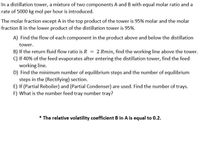
Introduction to Chemical Engineering Thermodynamics
8th Edition
ISBN: 9781259696527
Author: J.M. Smith Termodinamica en ingenieria quimica, Hendrick C Van Ness, Michael Abbott, Mark Swihart
Publisher: McGraw-Hill Education
expand_more
expand_more
format_list_bulleted
Question
Please Solve parts D , E , F

Transcribed Image Text:In a distillation tower, a mixture of two components A and B with equal molar ratio and a
rate of 5000 kg mol per hour is introduced.
The molar fraction except A in the top product of the tower is 95% molar and the molar
fraction B in the lower product of the distillation tower is 95%.
A) Find the flow of each component in the product above and below the distillation
tower.
B) If the return fluid flow ratio is R = 2 Rmin, find the working line above the tower.
C) If 40% of the feed evaporates after entering the distillation tower, find the feed
working line.
D) Find the minimum number of equilibrium steps and the number of equilibrium
steps in the (Rectifying) section.
E) If (Partial Reboiler) and (Partial Condenser) are used. Find the number of trays.
F) What is the number feed tray number tray?
* The relative volatility coefficient B in A is equal to 0.2.
Expert Solution
This question has been solved!
Explore an expertly crafted, step-by-step solution for a thorough understanding of key concepts.
Step by stepSolved in 3 steps

Knowledge Booster
Learn more about
Need a deep-dive on the concept behind this application? Look no further. Learn more about this topic, chemical-engineering and related others by exploring similar questions and additional content below.Similar questions
- please help me with these.arrow_forward7.40. The cart in Fig. 7.38 has a mass of 2000 kg. It is resting on frictionless wheels on a solid, level surface and encounters no air resistance. At time zero it is standing still, and a jet from a fire hose is used to start it moving. The mass flow rate of the fluid from the fire hose is 100 kg / s, and its velocity relative to fixed coordinates is 50 m/s. The cup on the rear of the cart turns the jet around so that it leaves in the -x direction with the same velocity relative to the cart with which it entered. Calculate the velocity-time behavior of the cart; assume the jet is unaffected by gravity. (This is not a very practical problem, but it is analogous to the more complex and interesting problem of starting a large turbine from rest. All such turbines must be occasionally shut down for maintenance; their starting and stopping behavior is more complex than their behavior running at a steady speed.)arrow_forward. (Grinding Operations and Grinding Machines) (USCS units) In a centerless grinding operation, the grinding wheel diameter = 8 in, and the regulating wheel diameter = 5.0 in. The grinding wheel rotates at 1500 rev/min, and the regulating wheel rotates at 180 rev/min. The inclination angle of the regulating wheel = 2.3°. Determine the production rate of cylindrical work parts whose diameter = 0.5 in and length = 5.0 in. Solutions used; fr = TD₂N, sin Iarrow_forward
arrow_back_ios
arrow_forward_ios
Recommended textbooks for you
 Introduction to Chemical Engineering Thermodynami...Chemical EngineeringISBN:9781259696527Author:J.M. Smith Termodinamica en ingenieria quimica, Hendrick C Van Ness, Michael Abbott, Mark SwihartPublisher:McGraw-Hill Education
Introduction to Chemical Engineering Thermodynami...Chemical EngineeringISBN:9781259696527Author:J.M. Smith Termodinamica en ingenieria quimica, Hendrick C Van Ness, Michael Abbott, Mark SwihartPublisher:McGraw-Hill Education Elementary Principles of Chemical Processes, Bind...Chemical EngineeringISBN:9781118431221Author:Richard M. Felder, Ronald W. Rousseau, Lisa G. BullardPublisher:WILEY
Elementary Principles of Chemical Processes, Bind...Chemical EngineeringISBN:9781118431221Author:Richard M. Felder, Ronald W. Rousseau, Lisa G. BullardPublisher:WILEY Elements of Chemical Reaction Engineering (5th Ed...Chemical EngineeringISBN:9780133887518Author:H. Scott FoglerPublisher:Prentice Hall
Elements of Chemical Reaction Engineering (5th Ed...Chemical EngineeringISBN:9780133887518Author:H. Scott FoglerPublisher:Prentice Hall
 Industrial Plastics: Theory and ApplicationsChemical EngineeringISBN:9781285061238Author:Lokensgard, ErikPublisher:Delmar Cengage Learning
Industrial Plastics: Theory and ApplicationsChemical EngineeringISBN:9781285061238Author:Lokensgard, ErikPublisher:Delmar Cengage Learning Unit Operations of Chemical EngineeringChemical EngineeringISBN:9780072848236Author:Warren McCabe, Julian C. Smith, Peter HarriottPublisher:McGraw-Hill Companies, The
Unit Operations of Chemical EngineeringChemical EngineeringISBN:9780072848236Author:Warren McCabe, Julian C. Smith, Peter HarriottPublisher:McGraw-Hill Companies, The

Introduction to Chemical Engineering Thermodynami...
Chemical Engineering
ISBN:9781259696527
Author:J.M. Smith Termodinamica en ingenieria quimica, Hendrick C Van Ness, Michael Abbott, Mark Swihart
Publisher:McGraw-Hill Education

Elementary Principles of Chemical Processes, Bind...
Chemical Engineering
ISBN:9781118431221
Author:Richard M. Felder, Ronald W. Rousseau, Lisa G. Bullard
Publisher:WILEY

Elements of Chemical Reaction Engineering (5th Ed...
Chemical Engineering
ISBN:9780133887518
Author:H. Scott Fogler
Publisher:Prentice Hall


Industrial Plastics: Theory and Applications
Chemical Engineering
ISBN:9781285061238
Author:Lokensgard, Erik
Publisher:Delmar Cengage Learning

Unit Operations of Chemical Engineering
Chemical Engineering
ISBN:9780072848236
Author:Warren McCabe, Julian C. Smith, Peter Harriott
Publisher:McGraw-Hill Companies, The